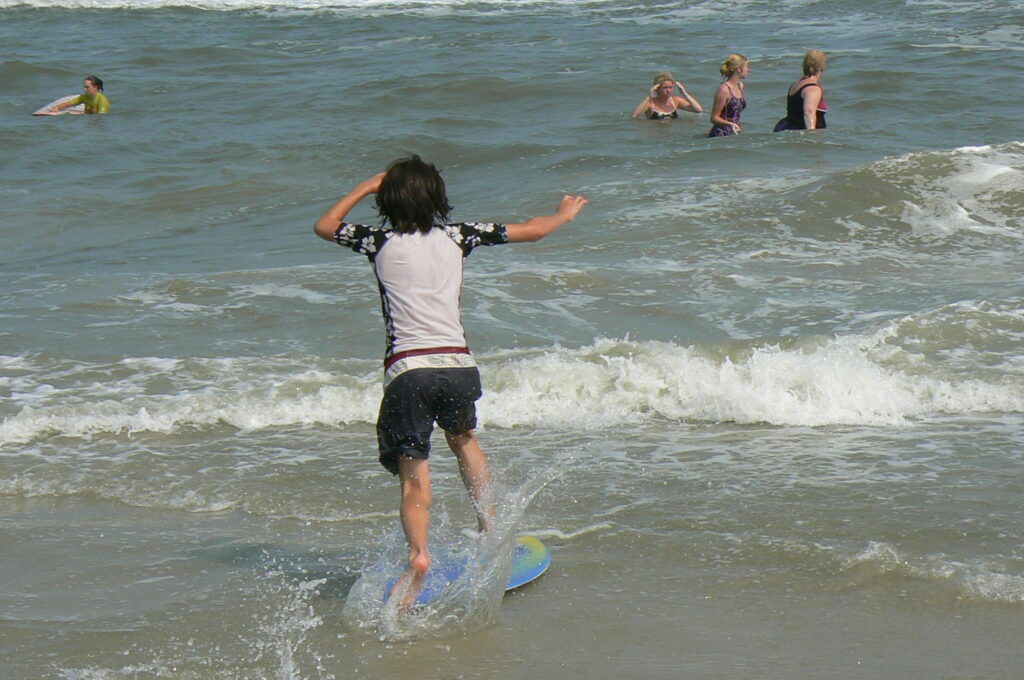The lure of jumping into the Chesapeake Bay on a hot summer day is intense. But when pollutants and bacteria are in the water, swimming becomes more of a risk rather than a pleasure.
When is it safe to swim? And where do you find this important information before you dip your toes in?
Since everything flows downstream, it’s important for swimmers to be informed and proactive.
Heavy rains are expressways for pollutants entering the Bay. Water quality can change with a single rainstorm, so some days our waters are not safe waters.
Nitrogen in the Bay primarily gets there by way of agricultural runoff, including your home lawn and garden. An excess of nitrogen can cause algae blooms, which block sunlight and oxygen from reaching aquatic plants and animals. The blooms of blue-green algae (which is really cyanobacteria) can sicken people and animals as well as the water and its inhabitants.
Bacteria, including the much-feared vibrio, occur naturally in brackish water like the Bay and its tributaries. It’s when the bacteria levels get too high that they can cause a variety of nasty health issues, from gastrointestinal to gangrene and blood infections. When fecal bacteria is washed into the water after a storm, it ends up in the Bay where it can make you (and your pets) sick.
In such a stew, swimming with open sores, cuts or ear infections makes us susceptible and can cause life-threatening skin and blood infections and intestinal illnesses. Stay out of the water within 48 hours of a heavy rain. Avoid swimming if you feel ill and have open cuts or sores. You can help keep the water clean by taking your trash with you, properly disposing of diapers and pet waste, keeping sewage on your boat, and other important practices.
Before you take that dip, there are several places where you can find recent water quality testing, primarily done by local health departments and select Riverkeepers (a network of nonprofit organizations that advocate for fishable, swimmable waterways).
Eyes on the Bay (https://tinyurl.com/2ut58tap) is Maryland’s hub for many of these reports. The Maryland Healthy Beaches Program (https://tinyurl.com/36a978b9) which is listed on the Eyes on the Bay site is also available as an app. There you’ll find information gleaned from monitoring water conditions at nearly 200 beaches in Maryland from Memorial Day to Labor Day with color-coded status reports on beaches throughout the state and daily updates on rainfall.
In Virginia, consult the Beach Map (https://tinyurl.com/mpthehw2) for the current status of Virginia’s public coastal beaches. The state health department is also active on Twitter, where you can find advisories too (@VDHBeach). Bacteria levels in beach water are monitored at 45 public beaches in Virginia on the Chesapeake Bay and Atlantic Ocean during the swimming season (May–September).
Most Riverkeepers across the Chesapeake Bay watershed are now displaying their results on the Waterkeeper Swim Guide Map/App.
Swimming is one of the highlights of summer. Enjoy it safely.
Kathy Knotts has spent over 20 years in media as a writer and former editorial staffer at Chesapeake Bay Magazine and Bay Weekly. A native of Louisiana, she loves good books, good food and good cocktails.




